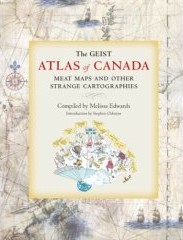Review: The Geist Atlas of Canada
The Geist Atlas of Canada: Meat Maps and Other Strange Cartographies
by Melissa Edwards
Arsenal Pulp Press, 2006. Softcover, 128 pp. ISBN 1-55152-216-0
 Early on in The Map Room’s existence, we learned about a quirky feature emanating from Geist, a quarterly Vancouver-based literary magazine. Called Caught Mapping, it presented a map of Canada based on a whimsical theme that pointed to placenames that fit that theme — for example, “The Meat Map of Canada” has pointers to Lac Steak, Rump Cove and Mignon Corner. There were many others: maps of board games, house pets, automotive terms. There was a map for Margaret Atwood and a map for Stan Rogers. The feature proved very popular and went on to attract quite a bit of media attention, putting Geist on the map, so to speak. But I like to think that you heard about it here first.
Early on in The Map Room’s existence, we learned about a quirky feature emanating from Geist, a quarterly Vancouver-based literary magazine. Called Caught Mapping, it presented a map of Canada based on a whimsical theme that pointed to placenames that fit that theme — for example, “The Meat Map of Canada” has pointers to Lac Steak, Rump Cove and Mignon Corner. There were many others: maps of board games, house pets, automotive terms. There was a map for Margaret Atwood and a map for Stan Rogers. The feature proved very popular and went on to attract quite a bit of media attention, putting Geist on the map, so to speak. But I like to think that you heard about it here first.
Now those maps have been assembled in a book, The Geist Atlas of Canada: Meat Maps and Other Strange Cartographies, which offers a few advantages over the individual maps, at least as they’re found in Caught Mapping’s online archives. For one thing, they’re in colour. For another, facing each map is a bit of an explanation of some of the names on the map, changes since it was first published, and feedback from readers wondering why their favourite place names were left out. And, most usefully, all the place names are listed in an index at the back of the book.
Caught Mapping is essentially a work of toponymy: the modus operandi behind each map seems to be to choose a theme (for example, kitchen implements) and then searching a reference like the Geographical Names of Canada to find toponyms that fit that theme (for example, Spoon Lake). In some cases, the results turn up some very unusual placenames; in others, the association between the theme and the placename is not immediately obvious (for example, “Glenn” on the celestial map), and requires a little free association, if not a footnote. And some maps reveal placenames that sound like they’re named after someone famous, but in fact are named after someone local and otherwise forgotten.
To be honest, a collection like this can get a little repetitive. Some of the map themes are a little too precious, and each map (save two) is the same map of Canada (a “modified Geistonic projection” that is just laterally compressed) with an off-kilter compass rose. But there’s plenty here that’s entertaining and amusing. If you’re curious about unusual place names, and a bit of the history behind them, you’ll find a lot to enjoy in this book.
I received a review copy of this book. More about my book review policy.
Previously: Geist Gallery Details; Geist Exhibition, Media Coverage; Geist Mapper; Caught Mapping Archives; Caught Mapping.
- Buy The Geist Atlas of Canada at Amazon.ca

Comments
blog comments powered by Disqus